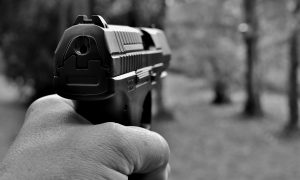Overview
Police use of excessive force is one of the most well known examples of implicit bias towards African Americans within the criminal justice system. Many argue that police are simply racist or that African Americans antagonize the police. Neither of these are true, however, when considering the situations the following criteria about implicit bias and police use of excessive force.
- Humans are “most vulnerable to human psychological frailties” during high pressure events, when they are tired, and when they are surrounded by out-group members (Jacobs & Jackson, 2017, p. 362). This criteria describes many police shootings.
- Research has shown that in-group members have a hard time processing the emotions of the out-group, such as a white man rating a neutral African American’s face as hostile, which “constitutes a form of dehumanization”, thus white officers may have trouble reading African American’s facial expressions (Jacobs & Jackson, 2017, p. 351).
- Shooter bias tests, another form of testing implicit bias, reveal that “participants tend to shoot black perpetrators more quickly and more frequently than white perpetrators”, with police officers following this trend as well, except they are more accurate when shooting than the general public (Levinson & Smith, 2012, p. 16).
Clearly, based on the above evidence, implicit bias is the largest challenge facing police officers that needs to be addressed.

Why Police Use of Excessive Force is Ethically Wrong
These incidents wrong simply because they have the terrible consequence of depriving someone of their life, as well as hurting loved ones in the process. Also, the fact that these treatment’s are unequally applied, as evidenced by the fact that in the 1970s police shot and killed eight African Americans for every one white person (Walker, Spohn, & DeLone, 2004, p. 103). Thus, police practices are clearly not being equally applied, violating the notion that all people have equal worth (universalism). Also, as these instances have the effect of making between one-third to one-half of African American men believe they have been unfairly treated by police at some point, which is wrong as no one should feel that they are unfairly singled out by the government or the police (Russell-Brown, 2009, p. 67). This, therefore, illustrates a deontic argument against racism within the criminal justice system.
Recommendations
Numerous recommendations have been proposed to deal with instances of police excessive force. For example, following the Ferguson shooting, President Obama created a task force to investigate strategies, as well as more of an emphasis on increased monitoring of police officer’s actions, using devices such as body cameras and new laws (Fridell & Lim, 2016, p. 37). While strategies like this may work, it is important to focus on the underlying issue of implicit bias.
One idea is to use training seminars and education to counteract implicit bias. This has been applied to other fields as well, as two hundred CEOs recently agreed to send their employees to implicit bias training, led by PricewaterhouseCoopers (Mac Donald, 2017). Evidence suggests that purposeful efforts to change officer’s implicit biases can make a difference as “officers who reported having positive contact with black people were less likely to shoot unarmed black suspects than were officers who had negative attitudes towards black people” (Dixon, 2010, p. 86). Thus, there is a popular trend towards implicit bias training, both inside and outside the legal field. When applying this to police officers, researchers have advocated for using simulations that allow specific situations where biases may affect officers to be practiced (Dixon, 2010, p. 85).
To the contrary, some psychologists argue that implicit bias trainings are meaningless. Social psychologist Lee Jussim, claims that “the research on implicit bias has been widely oversold” complaining that it has become one of several “oversold concepts” used in society as a quick fix to social problems (Jussim, 2017). Furthermore, he argues that implicit bias training does not work if people are not receptive to it (Jussim, 2017). While Jussim is correct in his assertion, as training is meaningless if people are uninterested, finding ways to circumvent implicit biases that have become deeply ingrained in one’s head takes more than just a day long training. These trainings do, however, begin a conversation about implicit bias, and like the Implicit Association Test (IAT) help people realize what biases they may have. A more appropriate form of training is continued video training for police officers as this would “reduce the impact of implicit biases on police decisions to use force”, focusing on using threat indicators instead of race when assessing risk (Fridell & Lim, 2016, p. 44). Psychologists argue that one of the best ways to do this is to ensure that the videos alternte demographics, as in there are as many threatening white women as there are black men (Fridell & Lim, 2016, p. 44). Like the solutions for the media, there is no quick or easy fix, yet continued exposure will help to eliminate some of these biases.